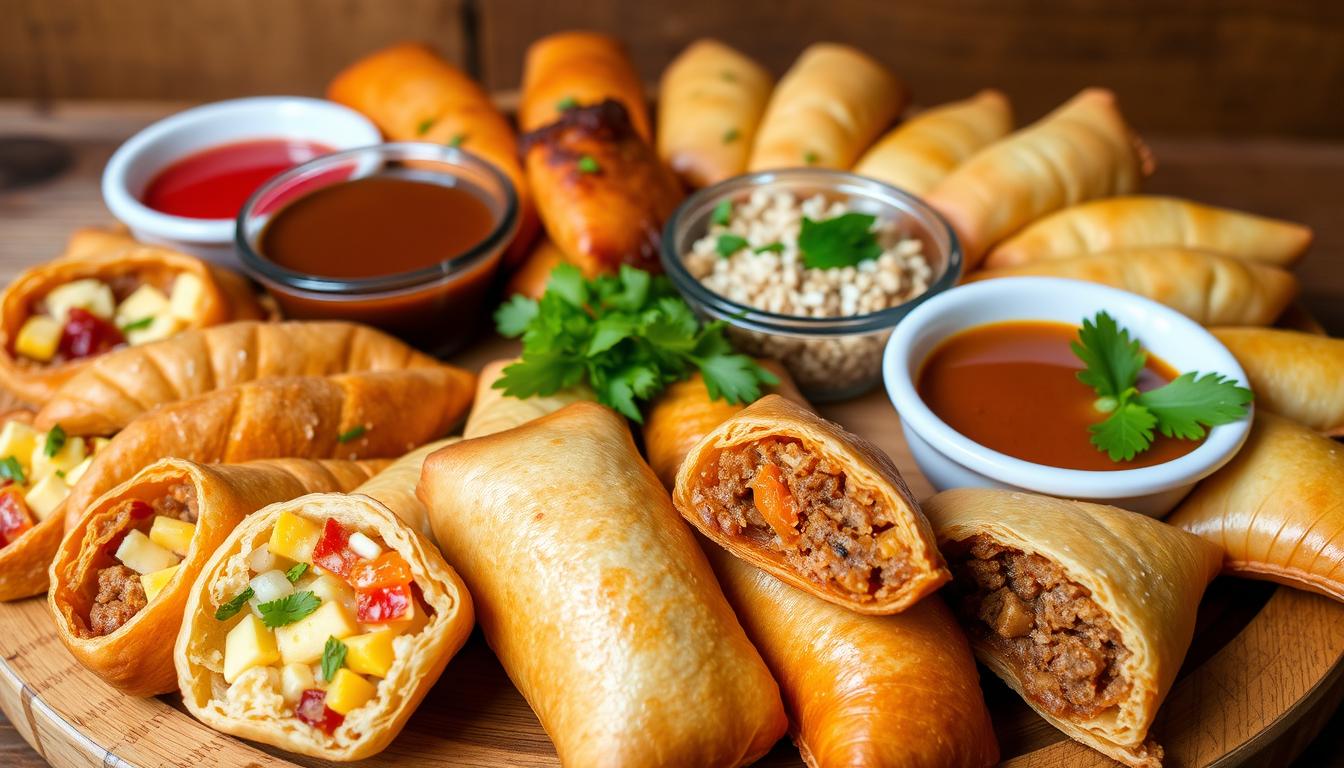Table of Contents
Sweet and Savory Pastelitos
Pastelitos, loved by many, are a key part of Latin American cuisine. These pastries are known for their flaky shells and tasty fillings. They show the rich food history of the area.
From sweet guava pastries to savory meat pies, there’s something for everyone. Pastelitos highlight the cultural importance and variety of this traditional treat.
Key Takeaways
- Pastelitos are a beloved Latin American pastry with a long history and cultural significance.
- These treats come in a variety of sweet and savory fillings, including guava, sweet potato, meat, and cheese.
- Pastelitos can be made with flaky or bready dough, and can be either fried or baked.
- Pastelitos are a popular street food and are often enjoyed at celebrations and gatherings.
- There are regional variations and specialties of pastelitos throughout Latin America.
Pastelitos : A Culinary Journey
Exploring the History and Cultural Significance
Pastelitos are loved Latin American pastries with a rich history. They started in the Spanish colonial era. Over time, they mixed European and South American flavors and methods.
These treats are found in Puerto Rico and Cuba. They show the cultural mix of Latin America. Pastelitos are both savory and sweet, loved by many.
They remind people of their childhood and cultural heritage. In Puerto Rico, they’re a special holiday food. Abuela makes them for Thanksgiving, linking them to tradition.
The ingredients in pastelitos vary, showing the diversity of Latin American cultures. They use root vegetables like green bananas and potatoes. Fillings can be meat or sweet, like guava.
There’s a debate on whether to use green plantains. This shows the different tastes and traditions across the region.
“Pastelitos are a staple at big family dinners, birthdays, holidays, and Easter gatherings, reflecting their deep cultural significance and the cherished memories attached to them.”
Pastelitos have spread, taking on new flavors and methods. In the Dominican Republic, they mix traditional tastes with unique ways of making them. Whether fried or baked, they connect past and present, celebrating Latin American food traditions.
The Versatility of Pastelitos
Pastelitos are amazing because they can be filled in so many ways. You can choose from sweet treats like guava and cream cheese or savory options like meat. This makes pastelitos perfect for anyone who loves to try new things and make their food their own.
These pastries are loved in many Latin American countries. They can be a sweet delight or a tasty snack. Plus, you can decide if you want them fried or baked.
| Filling Type | Example Flavors |
|---|---|
| Sweet | Guava, cream cheese, sweet potato, pineapple |
| Savory | Beef picadillo, ham and cheese, spinach and feta |
Pastelitos are a hit because they can be anything you want. Whether you’re in the mood for something sweet or savory, they bring a taste of tradition with endless possibilities.
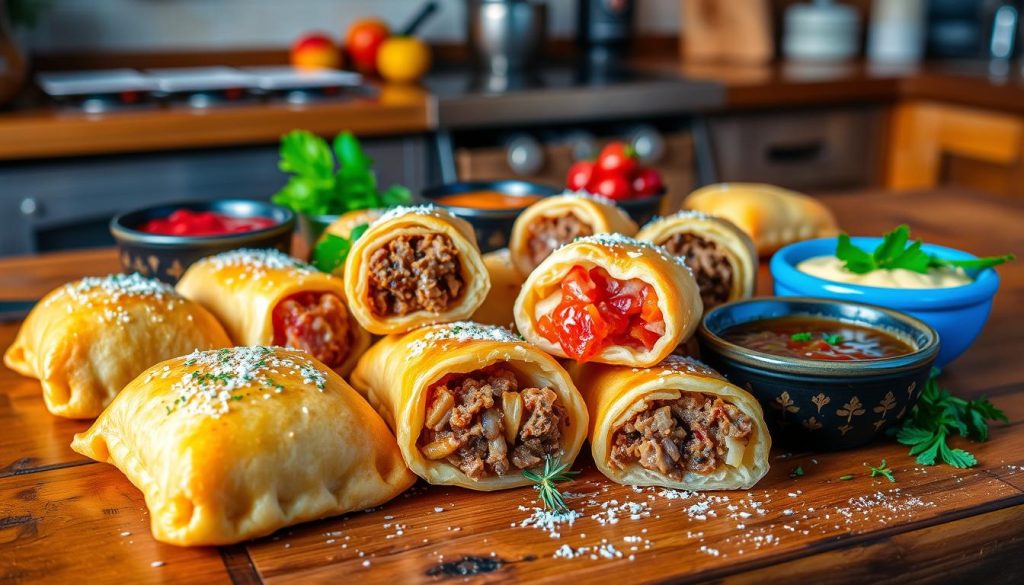
Traditional Fillings and Flavors
The heart of a pastelito is its filling. Traditional Latin American flavors have shaped these pastries’ taste. Sweet delights like guava, sweet potato, and coconut add tropical sweetness to each bite. Warm spices like cinnamon enhance the flavor, creating a balance that delights.
Sweet Delights: Guava, Sweet Potato, and More
Guava pastries are among the most iconic traditional pastelitos fillings. Their vibrant color and tart-sweet flavor make guava a favorite for sweet pastelitos. Sweet potato fillings are also popular, offering a creamy and comforting taste with natural sweetness.
- Guava Pastries: A classic pastelito filling that celebrates the tropical taste of guava.
- Sweet Potato Fillings: A rich and indulgent option that adds a natural sweetness to the pastelito.
- Coconut-Infused Delights: The fragrant and nutty flavor of coconut complements the pastelito dough beautifully.
- Cinnamon-Spiced Treats: A touch of warm cinnamon elevates the overall flavor profile of the pastelito.
These traditional pastelitos fillings not only please the taste buds but also showcase Latin American culinary heritage. Whether you prefer a sweet and tangy guava pastry or a comforting sweet potato treat, there’s a wide range of options for the perfect pastelito.
Meat, Cheese, and Vegetable Fillings
Sweet savory pastelitos are loved, but savory ones are just as popular. Fillings like picadillo (spiced beef) offer a richer taste. Cheese, from queso fresco to mozzarella, adds a creamy, gooey touch. Vegetable fillings, like peppers and onions, are lighter and healthier.
From Picadillo to Queso Fresco
Savory pastelito fillings mix flavors and textures. Meat fillings, like picadillo, blend ground beef, onions, and spices for a bold taste. Cheese fillings can be creamy queso fresco or melty mozzarella, adding richness. Vegetable fillings with sautéed peppers and onions are a nutritious choice.
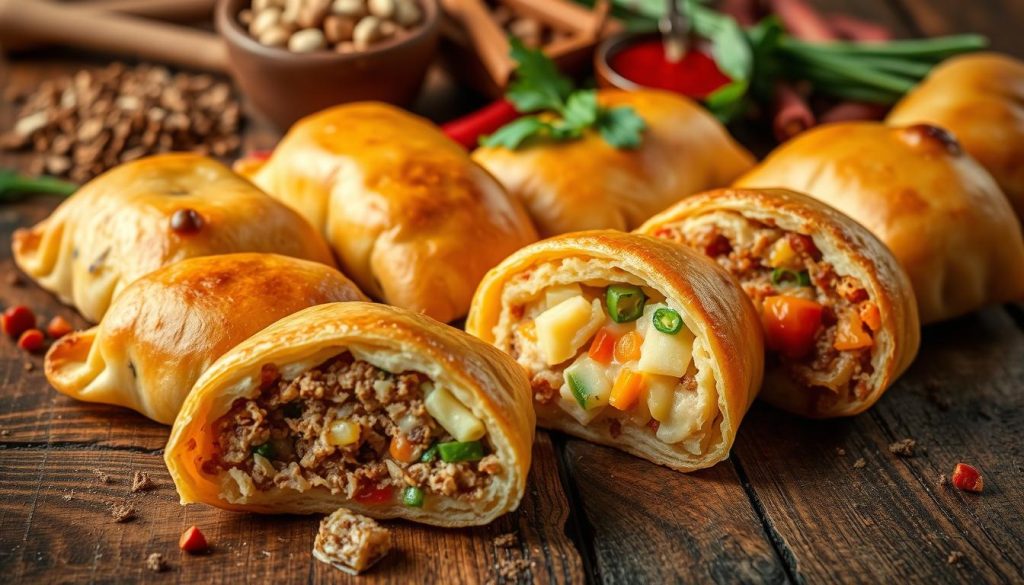
Whether you love meat fillings, cheese fillings, or vegetable fillings, there’s a savory pastelito for everyone. These pastries are a favorite in Latin American cuisine. They show the diversity and traditions of pastelito making.
The Art of Making Pastelitos
Making pastelitos is a skill passed down through generations. It involves preparing the dough, shaping, and filling. Each step needs skill and care. Whether frying or baking, the techniques used by experts are key to a delicious result.
To make the dough, you need 10 ounces of unsalted butter, 1/2 cup of cold water, 1 teaspoon of fine sea salt, and 2 cups of all-purpose flour. The dough is then shaped and filled with sweet or savory ingredients. Favorites include guava, sweet potato, meat, and cheese.
Choosing how to cook the pastelitos is the next step. Some like frying for a crispy exterior, while others prefer baking for a flaky texture. After cooking, they’re brushed with a syrup made from 1/2 cup of white sugar and 1/2 cup of water. This adds sweetness and shine.
Before cooking, the pastelitos are brushed with an egg wash. This is made from 3 eggs and 2 ounces of water. It helps them get that golden color. They cook for 30 to 40 minutes at 350 degrees Fahrenheit. After adding the syrup, they cook for an extra 5 to 6 minutes.
Making pastelitos is a labor of love. The result is a treat loved worldwide. Whether you’re experienced or new, making these pastries is a journey worth enjoying.
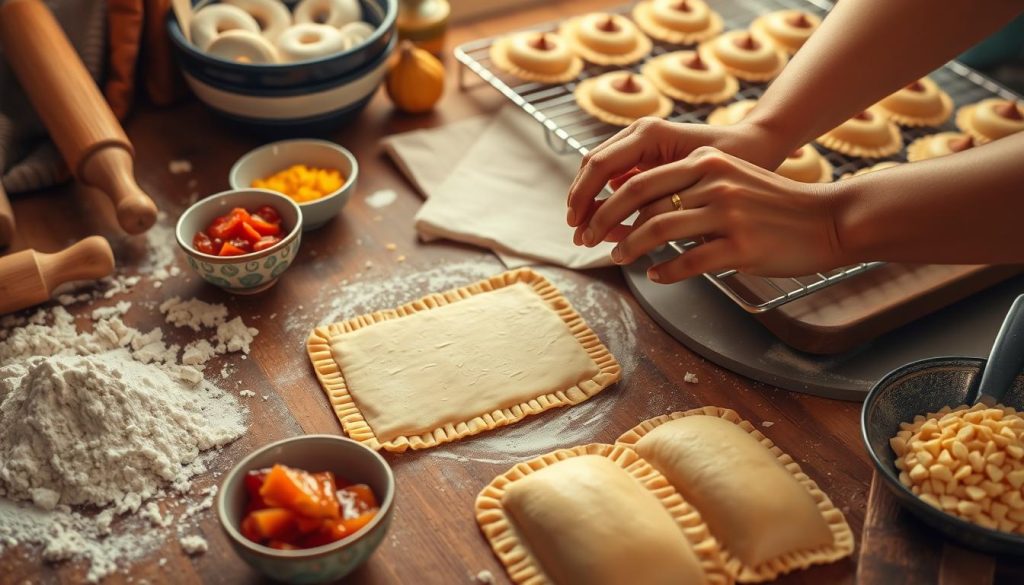
Perfecting the Dough
The dough is the base of pastelitos’ vibrant flavors. You might like a flaky shell that breaks easily or a bready one. Either way, getting the dough right is key to a great pastelito.
For years, people have argued over the best dough texture. Some love the flaky, crisp feel, while others prefer the bready, hearty taste.
Flaky or Bready? Finding Your Dough Preference
Choosing between flaky and bready dough is a matter of taste. Flaky dough fans enjoy the delicate, crisp texture. They say it’s like a symphony of flavors and textures, with each layer revealing the filling.
Bready dough lovers, on the other hand, prefer a heartier feel. They believe it lets the filling’s flavors stand out more.
It doesn’t matter which you prefer. What’s important is the care you put into making the dough. Every detail, from the ingredients to kneading and resting, matters for the perfect dough.
| Flaky Dough | Bready Dough |
|---|---|
| Delicate, crisp texture | Hearty, substantial mouthfeel |
| Layers that melt away | Allows filling flavors to shine |
| Requires precise dough preparation | Requires precise dough preparation |
Whether you’re Team Flaky or Team Bready, the quest for the perfect dough is exciting. It’s a journey of discovery, where every bite is a reward.
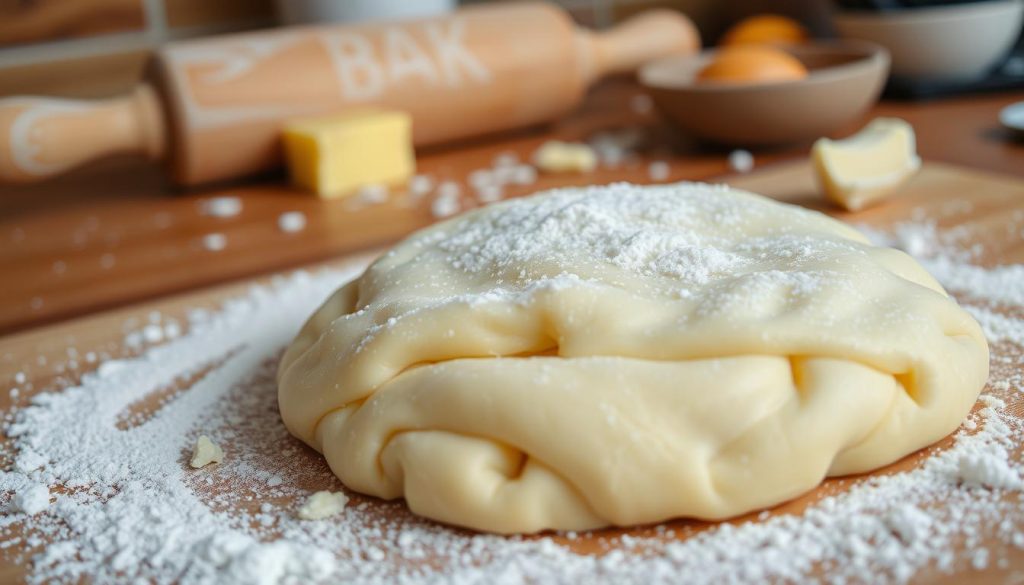
“The dough is the canvas upon which the pastelito’s flavors are painted, and the debate over the ideal texture has been a source of passionate discussion among enthusiasts.”
Frying or Baking: Choosing the Perfect Cooking Method
Choosing between frying and baking pastelitos can greatly affect the taste. Each method has its own benefits, fitting different tastes and preferences.
Frying pastelitos makes them crispy on the outside and soft inside. This texture mix is both satisfying and indulgent. The hot oil also enhances the flavors of the fillings.
Baking pastelitos gives them a delicate, flaky crust. This method lets the fillings’ natural flavors stand out. It’s a healthier choice for those watching their fat intake.
The choice between frying and baking depends on what you like. Both ways make delicious pastelitos, catering to various tastes.
| Frying Pastelitos | Baking Pastelitos |
|---|---|
| Crisp, golden-brown exterior | Delicate, flaky crust |
| Soft, fluffy interior | Light and airy texture |
| Seals in flavors of fillings | Allows natural flavors to shine |
| Indulgent, rich experience | Healthier, lower-fat option |
Whether you love the crispy fried pastelitos or the flaky baked ones, it’s your choice. Both ways are great for enjoying these Caribbean treats.
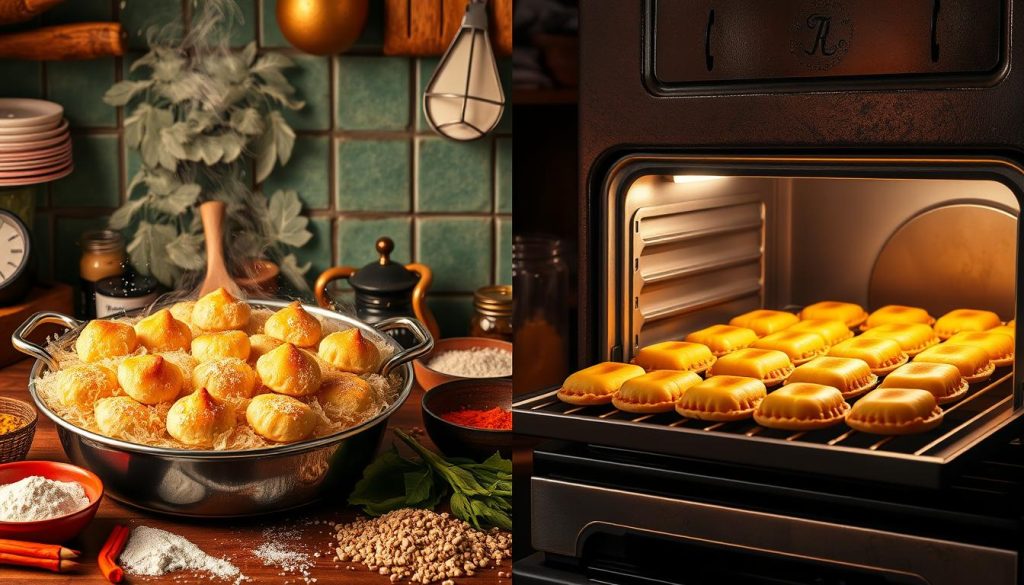
Pastelitos: A Beloved Street Food
Enjoying Pastelitos on the Go
Pastelitos are a favorite snack for those always on the move. They’re found in markets of Puerto Rico and plazas of Cuba. These portable pastries are key to Latin American street food culture.
In Miami, the mix of guava and cream cheese pastelitos is famous. Cuban bakeries in Hialeah meet the demand for these on-the-go snacks. Pastelitos were scarce during Cuba’s “Special Period,” showing their importance.
Now, pastelitos still delight many. You can find them in donut shops, bakeries, and food trucks. They’re a big part of Latin American street food culture.
“Pastelitos have the power to transport you to the heart of the region’s culinary traditions.”
Pastelitos for Celebrations and Gatherings
Pastelitos are a big deal in Latin America. They’re the stars of family parties and community events. These treats bring people together, showing off cultural pride.
In Venezuela, pastelitos are a must-have for any meal. They come in many shapes and fillings like beef, cheese, and chicken. A single batch can make about 50 pastelitos, depending on their size.
But pastelitos aren’t just for Venezuelans. They’re also a hit at Dominican parties. They’re often enjoyed with Malta, a favorite drink in Venezuela. Fried pastelitos are the most traditional and popular choice.
| Pastelito Preparation | Fried Pastelitos | Baked Pastelitos |
|---|---|---|
| Dough | 3 cups all-purpose flour, 1 stick of butter | 3 cups all-purpose flour, 1 stick of butter |
| Resting Time | 1 hour | 1 hour |
| Cooking Method | Deep-fried until golden brown | Baked at 350ºF for 20-25 minutes |
| Serving Suggestions | Can be served with guasacaca or salsa verde | Can be served with guasacaca or salsa verde |
Making pastelitos involves cutting out thin discs, filling them, and frying until golden. The dough’s thinness and quick frying are key to their freshness. Mozzarella cheese and fried pastelitos are especially tasty.
Pastelitos are a big part of Latin American traditions. They bring people together, celebrating cultural identity and unity. Whether at family gatherings or community events, these pastries are a cherished symbol.
Regional Variations and Specialties
In Latin America, pastelitos show off the unique tastes and ingredients of each place. From guava-filled treats in Puerto Rico to meaty pastelitos in Argentina, each one tells a story of the continent’s rich culture.
In Colombia and Venezuela, empanadas are made with corn flour and fried. They’re filled with pork and potato in Colombia, and chicken, cheese, or fish in Venezuela. Argentina has its own empanadas, like Tucuman ones with minced meat and egg, and criollas with minced meat, olives, chives, and potatoes.
Chilean empanadas use wheat flour and are filled with ground meat, onion, spices, eggs, and olives. The Galician empanada, from Spain, is also found in Latin America. It’s the base for many regional versions, like those in Puerto Rico.
In Puerto Rico, people call similar dishes empanadilla in the south and pastelillo in the center and north. The dough’s color and how it’s folded can tell you where it’s from.
The debate over names shows the cultural diversity and gastronomic richness of Latin American cuisine. This is true in Central Florida and everywhere else.
“The diversity of pastelitos in Latin America is a testament to the rich culinary traditions that have been passed down through generations.”
These regional specialties are not just tasty. They also show the amazing diversity of Latin American cuisine. They invite everyone to try and enjoy the vibrant flavors of this beloved pastry.
Nutritional Breakdown of Pastelitos
Pastelitos are tasty, but we must think about their nutrition too. They have calories, fats, carbs, and nutrients from puff pastry, fillings, and oils. Knowing this helps us enjoy pastelitos in a healthy way.
A single serving of pastelitos (86g) has 326 calories. It’s made up of 6% protein, 50% carbs, and 44% fat. They also have 1.9g of dietary fiber, which is 7% of our daily value.
| Nutrient | Amount per Serving | % Daily Value |
|---|---|---|
| Total Fat | 15.9g | 20% |
| Saturated Fat | 4.8g | 24% |
| Trans Fat | 2.5g | – |
| Cholesterol | 8.6mg | 3% |
| Sodium | 198.7mg | 8% |
| Total Carbohydrate | 41.1g | 15% |
| Dietary Fiber | 1.9g | 7% |
| Total Sugars | 14.6g | – |
| Protein | 4.7g | 9% |
| Iron | 1.8mg | 10% |
Pastelitos should be part of a balanced diet. They’re tasty but high in fat and carbs. This can lead to weight gain and health issues if eaten too much. Knowing their nutritional value helps us enjoy them wisely.
Pairing Pastelitos with Beverages
Pastelitos, the flaky and delicious Cuban pastries, are often enjoyed with traditional Latin American drinks. These pairings make the experience even better. Whether it’s a strong Cuban coffee or a sweet tamarind juice, these drinks not only taste great but also show the rich culture behind these pastries.
The bold flavors of Cuban coffee match the rich fillings and buttery pastry of pastelitos perfectly. The coffee’s bold taste and smooth texture balance the pastry’s sweetness. This makes every bite a delightful mix of flavors.
For a lighter option, try tamarind juice with pastelitos. The juice’s tartness cuts through the pastry’s richness. It cleanses your palate and lets the pastelito’s unique flavors stand out.
Pastelitos can also be paired with many other Latin American drinks. From the earthy yerba mate to the sweet horchata, each pairing offers a unique taste experience. These combinations take you on a journey through the diverse culinary traditions of the region.
| Beverage | Flavor Profile | Pairing Notes |
|---|---|---|
| Cuban Coffee | Bold, Complex, Creamy | The rich, bold flavors of Cuban coffee perfectly complement the sweetness and buttery texture of pastelitos. |
| Tamarind Juice | Tart, Tangy, Sweet | The refreshing and palate-cleansing properties of tamarind juice balance the richness of pastelitos. |
| Yerba Mate | Earthy, Aromatic, Energizing | The herbaceous notes of yerba mate complement the sweetness of pastelitos, creating a harmonious pairing. |
| Horchata | Sweet, Creamy, Cinnamon-Flavored | The creamy and fragrant horchata enhances the flavors of pastelitos, creating a comforting and indulgent experience. |
Enjoying pastelitos with the right drink can make the experience even better. It takes you to the world of Latin American culinary traditions. Whether it’s a snack or dessert, the right drink can make it special.
“Pastelitos and coffee are a match made in heaven. The rich, bold flavors of the coffee perfectly balance the sweetness and flakiness of the pastry.”
Modern Twists and Innovations
Traditional pastelitos are still loved, but new ideas are making them even more exciting. Chefs and home cooks are mixing up flavors and adding global twists. They’re making pastelitos with new fillings and cooking methods, making them more versatile and tasty.
One cool thing happening is mixing pastelitos innovation with flavors from around the world. Imagine a pastelito with Indian spices or a Japanese version with matcha glaze. These fusion cuisine ideas make pastelitos fresh and show off chefs’ creativity.
Home cooks are also joining in, making their own creative pastelitos. They’re filling them with sweet potatoes and pecans or kale and goat cheese. These homemade versions let people try new things and celebrate their own tastes and local flavors.
Visit our Medium Page : The Refinado

